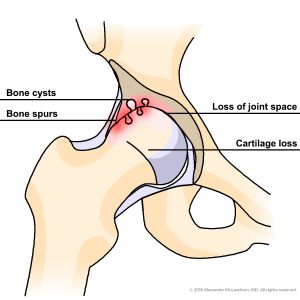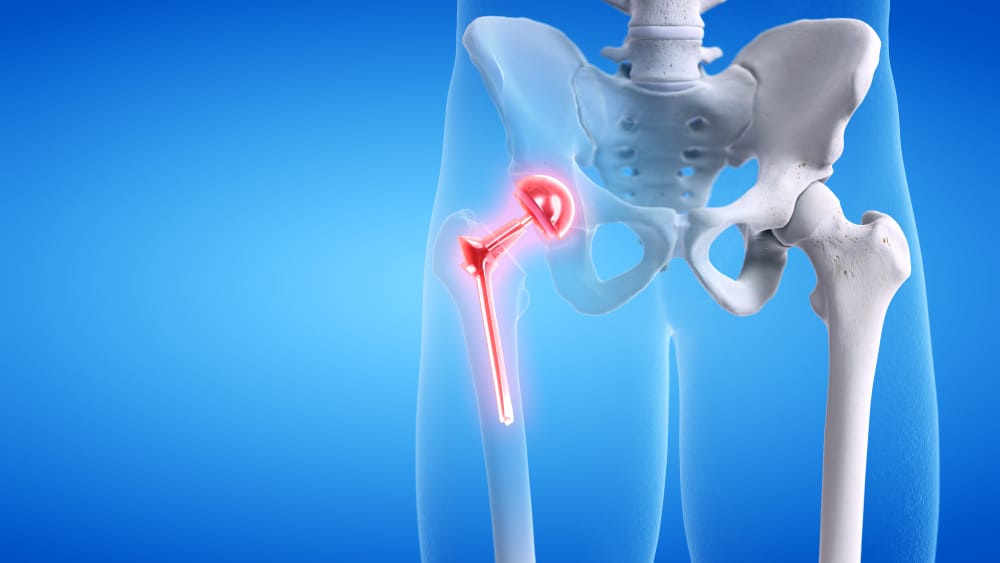
What is hip arthritis?
Arthritis is characterized by damage to the surfaces of the joint where they make contact with one another. In the hip, arthritis impacts the head of the femur (ball on top of the thigh bone) and the acetabulum (socket), which is part of the pelvis. In healthy hips, the surfaces of these bones in the hip joint are covered by a protective covering of cartilage. When cartilage breaks down due to injury, aging, inflammatory disease, or normal wear and tear, the bones begin to rub directly against one another. This results in arthritis that causes joint pain, stiffness, and immobility. There are several different types of hip arthritis.
What are the different types of hip arthritis?
Though the symptoms associated with hip arthritis may be similar regardless of the type of arthritis, the reasons for developing the disease can range. In general, arthritis can be divided into primary arthritis and secondary arthritis. Primary arthritis includes osteoarthritis and the inflammatory arthritides, such as rheumatoid arthritis, and secondary arthritis occurs because of other conditions affecting the hip, such as abnormal hip shape or trauma.
Primary Arthritis
Osteoarthritis of the Hip
Osteoarthritis (OA) of the hip is a common condition, characterized by gradual degeneration of the cartilage in the hip joint due to wear and tear. There is a genetic predisposition for the development of primary osteoarthritis, and it is most frequently seen in patients of European ancestry. Osteoarthritis usually develops slowly, resulting in eventual bone-on-bone contact, pain, and stiffness. Bone spurs and cysts within the bone develop in advanced cases.

Inflammatory Arthritis of the Hip
Inflammatory arthritis is a group of autoimmune diseases. These forms of arthritis occur as a result of one’s own immune cells attacking the joint and its lining, the synovium. These diseases may affect multiple or all joints in the body. Types of inflammatory arthritis include:
- Rheumatoid arthritis
- Psoriatic arthritis
- Ankylosing spondylitis
- Juvenile idiopathic arthritis
- Systemic lupus erythematosus
In some patients with these conditions, they develop osteonecrosis of the femoral head and eventual secondary arthritis as a side effect of disease treatment with chronic and/or high-dose steroids.
Learn more about inflammatory arthritis from hss.edu or arthritis.org.
Secondary Arthritis of the Hip
Secondary arthritis of the hip is a form of arthritis that is caused by another hip disorder. Secondary arthritis in the hip may result from:
- Trauma (following a hip injury)
- Hip infection
- Osteonecrosis or Avascular necrosis (AVN)
What causes hip arthritis?

Factors that may contribute to developing hip arthritis include:
- Normal aging
- Past injury to the hip joint
- Improper joint formation or shape (for example, hip dysplasia)
- Genetic defects affecting bone or cartilage
- Prolonged use of certain medications (for example, steroids)
- Overuse due to active lifestyle
- Excess body weight
What are the signs and symptoms?
Arthritis of the hip can manifest in different ways, depending on the individual. If you’re experiencing any of the following symptoms, you should consult an orthopedic hip specialist:
- Stiffness in the hip joint, especially when getting out of bed in the morning
- Inability to move the hip or reduced hip range of motion
- The feeling of bone rubbing against bone (sometimes accompanied by a “crunching” sound or feeling)
- Pain, soreness, or inflammation of the hip
- Aching in the hip joint after sitting or standing for a length of time
- Difference in leg lengths
- Difficulty performing everyday tasks, such as putting on your shoes and socks or clipping your toenails because of hip pain
- Hip pain that wakes you up at night
- Limp
How is it diagnosed?
Dr. McLawhorn will start by asking you a series of questions to better understand your current bone and joint health and your history pertaining to your hip condition. In addition to a medical history, a thorough physical evaluation will be performed, during which he will assess your walking, range of motion, and strength around the hip. X-rays are important part of your evaluation to look at the status of your hip joint. X-rays of other relevant areas, such as the lumbar spine, may be ordered if necessary for an accurate diagnosis. MRI is useful when there is further question about the health of the bone, cartilage, labrum, or muscles around the hip. CT is ordered selectively for patients requiring certain types of hip surgery. Blood work or injections into the hip or spine may be necessary for diagnosis in rare circumstances.
How is it treated?
Since hip arthritis is a progressive condition, the earlier that it is diagnosed and treated, the more likely it is that you can lessen its impact on your life. In some cases, hip arthritis pain can be well controlled with nonsurgical treatments. Dr. McLawhorn is committed to personalized care for all of his patients, using evidence-based methods and nonsurgical treatment options whenever possible. Nonsurgical treatments for hip arthritis may include:

- Rest
- Avoiding high impact activities
- Losing weight
- Physical therapy
- Taking anti-inflammatory medications
- Hip injections
- Using devices to assist walking, such as a cane
When hip arthritis is severe or is not responding well to nonsurgical treatment options, a surgical procedure may be necessary. Procedures recommended to relieve hip arthritis may include:
- Hip resurfacing is a surgical procedure involving removing the damaged portion of the bone and cartilage in the hip socket (acetabulum) and replacing it with a metal shell. The ball of the existing joint (femoral head) is then resurfaced with a smooth metal covering.
- Total hip replacement is a surgical procedure involving complete replacement of both the socket (acetabulum) and the ball (femoral head).
How Do I Prepare for My Initial Hip Arthritis Consultation?
Proper preparation for your initial hip arthritis consultation can help you get the most out of your visit. Here are some steps you can take to get ready to meet with Dr. McLawhorn:
- Gather your medical history. This includes any previous diagnoses, treatments, and medications related to your hip arthritis.
- Make a list of symptoms. Note their frequency, intensity, and what activities exacerbate them.
- Bring any relevant imaging studies. This includes X-rays or MRIs. They will provide a comprehensive picture of your condition.
- Write down any questions or concerns you have. This will help you remember to address all your worries during the appointment.
- Wear comfortable clothing. It should allow easy access to the hip area for a physical examination.
Who Is a Good Candidate for a Total Hip Replacement?
Dr. McLawhorn evaluates candidates based on several factors, including:
- The extent of hip arthritis damage
- Overall health
- Response to conservative treatments like medication and physical therapy
Ideal candidates are typically those who have not found relief from non-surgical treatments. They also experience persistent pain, stiffness, and limited mobility.
Dr. McLawhorn will conduct a thorough evaluation to determine if hip replacement is the best choice for you. He ensures that each patient receives the most appropriate hip arthritis treatment in NYC or Stamford, CT.
What Are Some Myths and Misconceptions About Total Hip Replacement?
Several myths and misconceptions exist regarding total hip replacement. These myths can cause unnecessary anxiety for patients.
- Myth #1: Hip replacements are only for older people.
- Reality: Age is not the sole determinant. The decision is based on the severity of arthritis and its impact on the patient's life.
- Myth #2: Hip replacements are prone to frequent failure.
- Reality: Advances in surgical techniques and materials have significantly improved hip replacements' durability and success rates. In fact, there is probably a greater than 95% odds of total hip replacement lasting a lifetime for most patients.
- Myth #3: Recovery is always lengthy and extremely painful.
- Reality: Recovery does require time and effort. However, modern pain management strategies and rehabilitation protocols have made it more manageable. Most patients are performing their activities of daily living within a month of surgery, and most patients can be back to the sports they enjoy by 3 months after surgery.
- Myth #4: Hip replacements restrict physical activity.
- Reality: Many patients return to an active lifestyle. Post-surgery, they can enjoy activities they once thought impossible, including skiing and intermittent running or jogging.
Dr. McLawhorn ensures patients have accurate information before deciding to undergo surgery. He helps them make informed decisions about hip arthritis treatment in NYC and Stamford, CT.
Are There Any Risks Associated with Total Hip Replacement?
As with any surgical procedure, total hip replacement carries some risks. Common risks include:
- Infection
- Blood clots
- Implant loosening or dislocation
Keep in mind these risks are relatively low. This is especially true when a skilled and experienced surgeon like Dr. McLawhorn performs the surgery.
Why Choose Alexander S. McLawhorn, MD?
When you choose Dr. Alexander McLawhorn for hip replacement surgery and hip arthritis treatment, you can trust you’ll receive individualized care tailored to your needs. Dr. McLawhorn performs over 600 joint replacement procedures annually. He uses advanced techniques and technologies to help patients achieve their recovery goals.
Dr. McLawhorn's expertise in direct anterior total hip replacement, robot and computer-assisted hip replacement, and rapid-recovery joint replacement sets him apart. He is one of the nation's most experienced surgeons for robot-assisted direct anterior approach THR. He performs over 400 of these surgeries each year.
If you believe you may be suffering from hip arthritis, it is important to seek advice from an orthopedic hip specialist to accurately diagnose and treat your condition. Dr. McLawhorn is a hip and knee specialist at Hospital for Special Surgery serving patients in New York and Connecticut. To learn more, call 203-705-2113 (CT) 212-606-1065 (NYC) today or schedule an appointment by using the form on this page.



